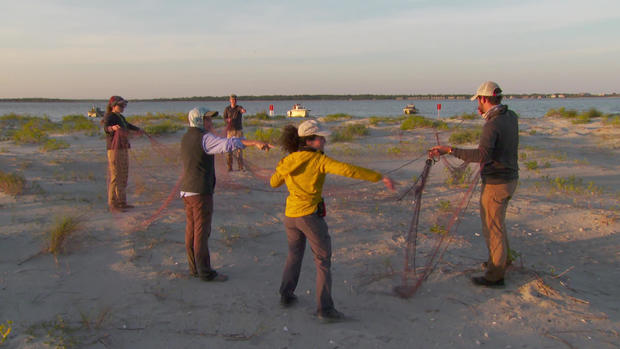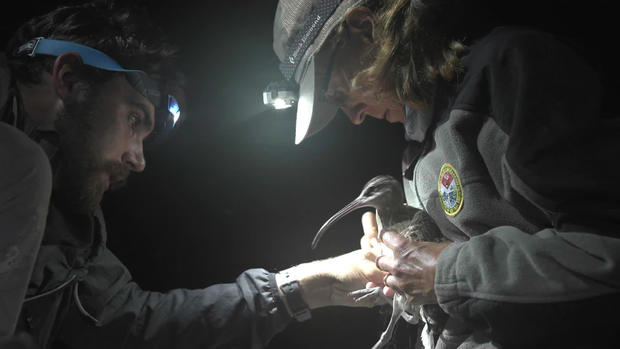A migration odyssey: Tagging whimbrel shorebirds
The whimbrel appear in the late afternoon sky above Deveaux Bank, a tiny island – a sandbar, really – just off the South Carolina coast south of Charleston. Crouched in the dunes, correspondent Martha Teichner watches with the scientists studying them.
University of South Carolina graduate student Maina Handmaker remembers the first time she saw what we were seeing: "And as we got nearer to sunset and high tide was coming in, it was just the most unbelievable thing I've ever seen – hundreds of whimbrel just streaming in over the horizon."
Clouds of birds against the sunset. You tell yourself, memorize the sight, and then you whisper to your soul: I'm glad to be alive, so I can witness this astonishing thing.
As night falls, they land, and sleep. Who knew? Until Felicia Sanders, a bird biologist from the South Carolina Department of Natural Resources, found herself at Deveaux Bank one spring morning in 2014, no one knew.
"I was really surprised!" Sanders said. "Just thousands of whimbrel came off the island right at sunrise. And to have that many at one place at Deveaux Bank, it just seemed very unusual, and maybe something that nobody else had discovered."
The world-renowned Cornell Lab of Ornithology, at Cornell University, called it "one of the most mind-blowing discoveries in the history of 20th- and 21st-century ornithology." Why? Because whimbrel are disappearing fast.
"These birds have been declining steadily in recent decades 4-5% every year," said Andy Johnson, who produces videos for the Cornell Lab. His academic study was whimbrel.
Teichner asked, "Why are they in decline?"
"There's sea level rise, and development on coastlines that converge and compress their foraging habitat and their roosting habitat," Johnston said. "And there's aspects of climate change that are affecting the timing of food availability. It's complicated! Yeah, they have a wide range of things that are hitting them from all sides."
What's most noticeable about a whimbrel is its long, down-turned bill, perfect for snatching crabs and other crustaceans out of the wet sand.
Johnson said, "The whimbrel are pretty big for shorebirds. I mean, they stand probably almost about a foot tall, long legs, long necks. But they're lighter than they look. You know, they're definitely less than a pound."
Which makes their 5,000-10,000 mile annual migration that much more remarkable. They winter along the northern coast of South America. En route to their summer breeding grounds, they pause for a month or so to rest and fatten up for their flight, non-stop, to the Arctic. Once their chicks hatch and can fend for themselves, they turn around and head back south.
Sanders said, "The best-guess estimate of this species is 80,000, and of the eastern population, the ones that go up and down the Atlantic coast, is 40,000."
A formal count on Deveaux Bank in 2019 amazed ornithologists. "We got almost 20,000 whimbrel at Deveaux," said Sanders.
That's half the entire eastern population, on this fragile, ever-changing bit of high ground.
All kinds of seabirds shelter on Deveaux Bank. Huge colonies of pelicans, terns, and gulls. Its continued existence as a safe haven is critical to the whimbrel's survival.
The moon would be full the April night "Sunday Morning" was there. The goal was to capture birds, tag them, and attach tiny, solar-powered tracking devices, to learn where they go, and how best to help them survive.
Handmaker said, "We still have another hour until high tide, though. We know the high tide's gonna be a little higher even than it was last night. So, we were kind of calculating where might the water come to tonight, and where do we think whimbrel will be roosting tonight, and placing the net accordingly."
Second-guessing wary whimbrel? Easier said than done.
Teichner asked, "How hard is it to achieve what you're trying to do?"
"Quite!" Handmaker replied. "This will be our fifth night in the past couple weeks trying to catch birds, and they have evaded us so far."
By nightfall, the whimbrel had evaded capture again, and higher-than-expected tides had swamped all of the nets.
Team Whimbrel kept at it. "This is maybe our 15th try in the last 4, 5, 6 weeks – I'm losing track, honestly," Handmaker said. "But, I don't have super-high hopes, considering how tough it's been. These birds are so darn brilliant."
Finally, on May 11th, they hit the jackpot – 14 captures. The good news: they managed to tag and put transmitters on two birds. The bad news: a lightning storm forced them to release the rest.
Sanders said, "You know, I kinda love the challenge. If it was easy, I wouldn't love it. And I'm glad the birds are winning. They should!"
Winning, but for how long? Without the work that's being done here at Deveaux Bank, how long?
For more info:
- South Carolina Department of Natural Resources
- Cornell Lab of Ornithology, Cornell University
- Whimbrel Identification (allaboutbirds.org)
- Whimbrel: Audubon Field Guide
Story produced by Mary Lou Teel. Editor: David Bhagat.








